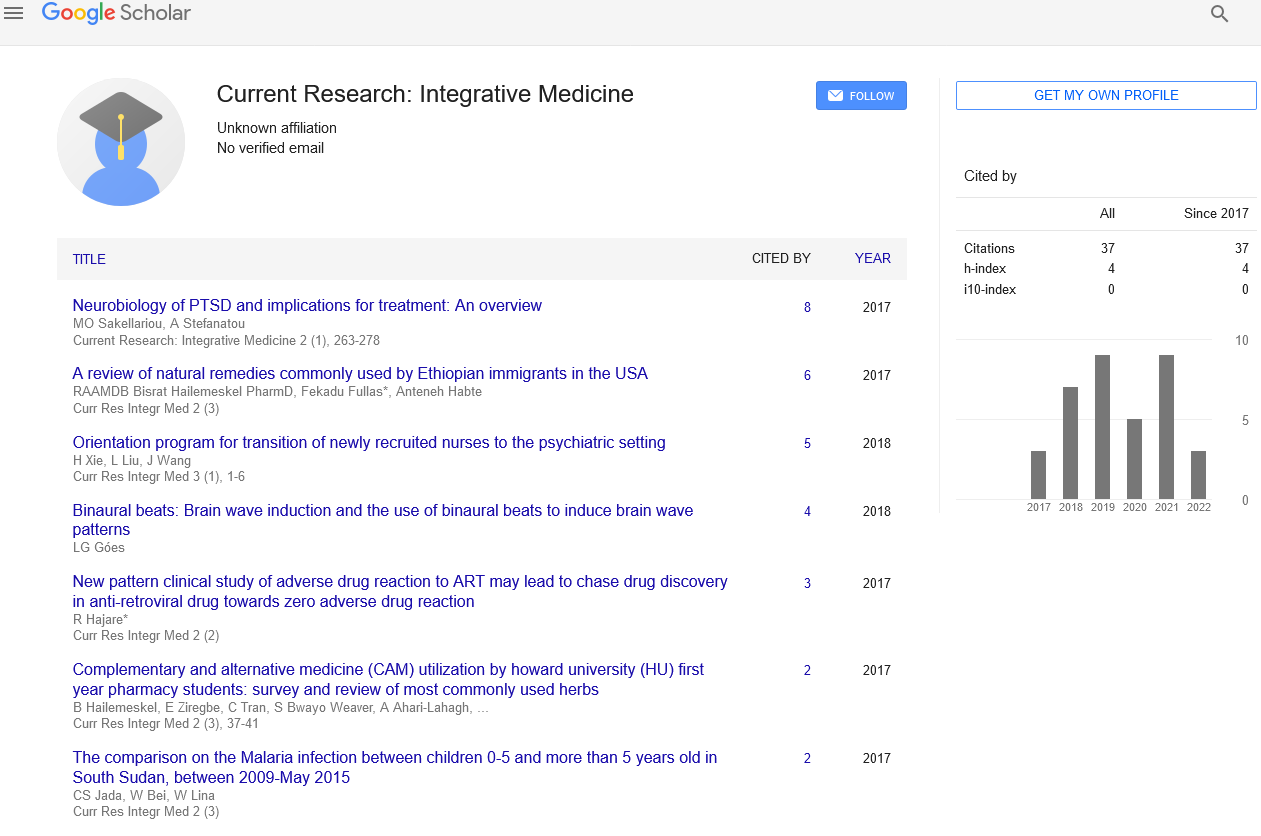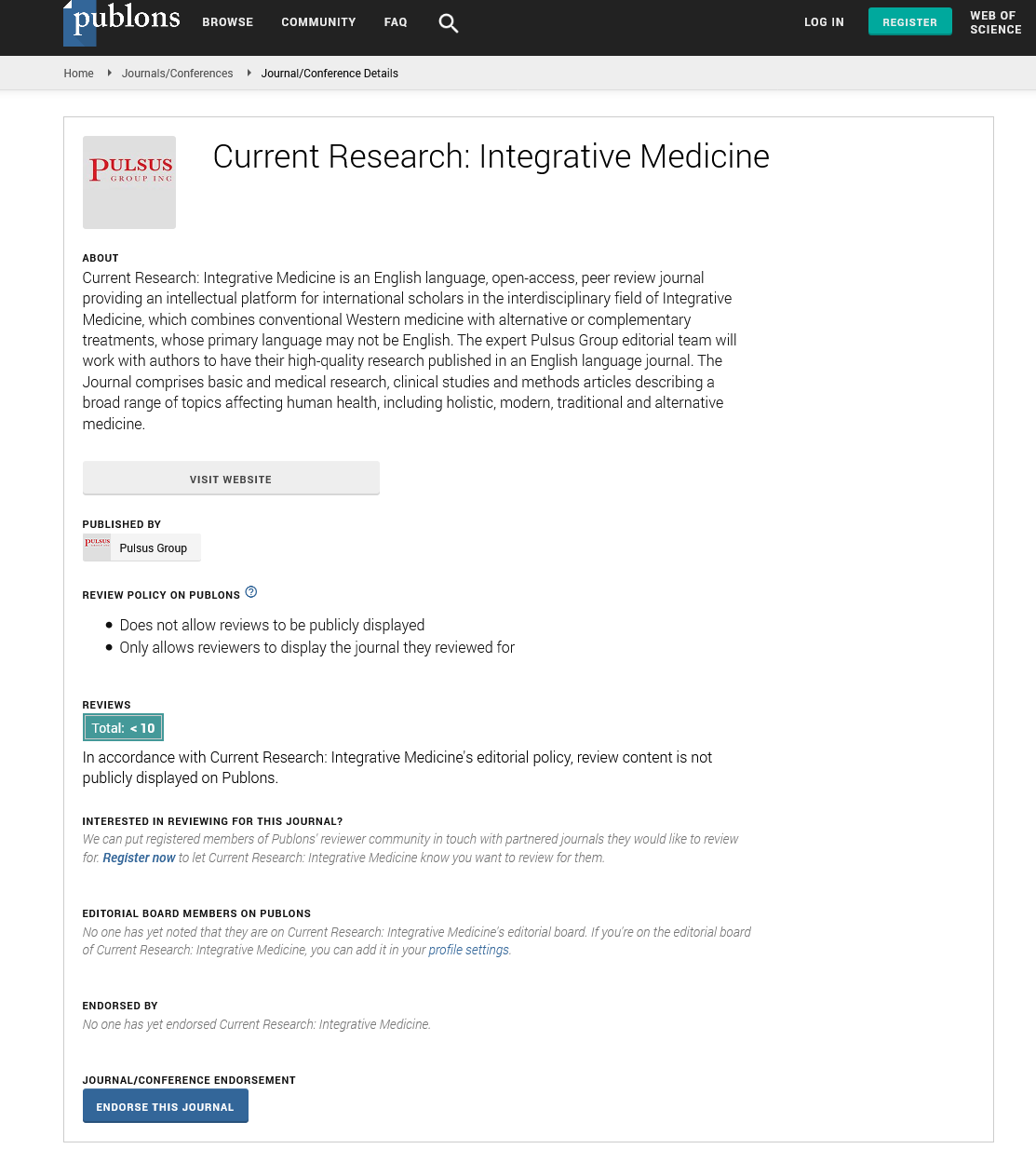Nutrition, diet and chronic degenerative disorders
Received: 12-Sep-2022, Manuscript No. PULCRIM-22-5520; Editor assigned: 14-Sep-2022, Pre QC No. PULCRIM-22-5520 (PQ); Accepted Date: Sep 27, 2022; Reviewed: 16-Sep-2022 QC No. PULCRIM-22-5520 (Q); Revised: 18-Sep-2022, Manuscript No. PULCRIM-22-5520 (R); Published: 28-Sep-2022, DOI: 10.37532. pulcrim.22.7 (5).12-13
Citation: Thomson A. Nutrition, diet and chronic degenerative disorders. Curr. Res.: Integr. Med.. 2022;7(5):12-13
This open-access article is distributed under the terms of the Creative Commons Attribution Non-Commercial License (CC BY-NC) (http://creativecommons.org/licenses/by-nc/4.0/), which permits reuse, distribution and reproduction of the article, provided that the original work is properly cited and the reuse is restricted to noncommercial purposes. For commercial reuse, contact reprints@pulsus.com
Abstract
Introduction
Chronic Degenerative Diseases (CDDs), are mainly represented by obesity, Cardiovascular Diseases (CVD), diabetes, chronic kidney disease (CKD), inflammatory bowel diseases, osteoporosis, sarcopenia, neurodegenerative diseases such as Huntington’s Disease (HD), rheumatoid arthritis (RA), chronic respiratory diseases, and many cancers, have been, up to now, the most frequent causes of prolonged disability and death worldwide.
The number of persons who pass away from a CDD before their time grows to over 17 million annually. Over 30% of people worldwide suffer from one or more CDDs, and 70%–80% of public health resources are currently allocated to managing these conditions. These statistics are made even more concerning by the most recent epidemiological predictions, which state that by 2030, CDDs will account for 80% of all diseases worldwide.
According to the Global Burden of Disease, behavioral risk factors like poor nutrition, a reduction in fruit and vegetable intake, a high body mass index (BMI) (25.0 Kg/m2 ), a smoking habit, a high alcohol consumption, and a lack of physical activity are the main causes of CDDs in terms of Disability Adjusted Life Y (DALY, which is equal to the sum of years of life lost due to premature death and those experienced in disease rather than health). The primary dietary factors that contributed to mortality were:
1. Reduced consumption of fruit (4.9 million attributable deaths/year), vegetables (1.8 million), nuts and seeds (2.5 million), and whole grains (1.7 million);
2. Increased sodium consumption (3.1 million).
A study by Noce et al focused on the antioxidant and antiinflammatory properties of extra virgin olive oil (EVOO) and underlined the significance of the MD in the treatment of CKD and associated comorbidities. Additionally, Domingues et al. suggested a supplementation strategy with creatine (Cr) to increase muscle oxygen saturation (StO2) and functional capacity in individuals with symptomatic Peripheral Artery Disease (PAD).
Phaseolus Vulgaris(PV) was recommended for ingestion in Jalal et alrandomized's controlled experiment to increase urine volume and improve the removal of tiny kidney stones. To preserve good bone health and preventing osteoporosis, Quattrini et al. looked at the level of MD adherence and dietary calcium consumption. Di Renzo et al. showed the value of a Modified MD (mMeD),ad low-carb diet enriched with antioxidant compounds, as a lipoedema treatment strategy. This diet can help reduce the subcutaneous limbic adipose tissue that is characteristic of this condition and enhance the quality of life by reducing pain, anxiety, and discomfort.An interesting review by Merra et al summarizes the importance of polyphenols, polyunsaturated fatty acids (PUFA) ω-3, and fiber in high quantity in the typical food of the MD to control eubiosis. The consumption of grapefruit (Citrus paradisi Macfad), bitter orange (Citrus aurantium L.), and olive leaf (Olea europaea L.) active products of immature citrus fruits has been suggested by Macarro et al. to lower the risk of CVD. These products can also improve Blood Pressure (BP), lipid profiles, thrombotic status, oxidative stress, inflammation, anthropometric variables, and quality of life. Additionally, a low Dietary Acid Load (DAL) resulting from high consumption of alkaline foods (fruits, vegetables, legumes, potatoes, and red wine) and a low intake of acidogenic items (such as meat, fish, cheese, grains, and cereals) contributed to a decrease in cardiometabolic diseases. Therefore, the predominance of cardiometabolic risk factors may be linked to the Western eating pattern. Changes in energy intake may play a significant role in slowing the progression of Parkinson's disease (PD) and involuntary weight loss, according to an intriguing cross-sectional study on the condition. Low MD adherence has been linked to HD, a rare neurological illness. Therefore, improving the course of HD may be accomplished by increasing the consumption of foods from the Mediterranean region and supplementing with certain nutrients, such as triheptanoin, L-acetylcarnitine, and creatine. Based on the papers published in the SI, it is apparent that the main risk factor for the development of CDDs is the nutritional transition of recent decades, which is characterised by the switch from the consumption of foods based on cereals, fruit, and vegetables to foods rich in saturated fats(primarily meat and dairy products) and simple sugars, associated with a diet characterised by a higher energy intake. Preventive measures in dietary habits and lifestyle choices, as proposed in the SI, may be able to, at least in part, stop the rise in CDDs. The Mediterranean diet and the promotion of a healthy, sustainable diet are intended to reduce the modifiable external risk factors that are linked to the risk of obesity, CVD, CKD, RA, and other CDDs.






